Abstract
Abandoned cropland is a great waste of land resources, which not only affects the stability of food production, but also wastes limited cropland resources. China has large areas of abandoned cropland, and accurately extracting the large-scale abandoned cropland is a prerequisite for the government to implement reclamation policies and estimate the food production potential of abandoned cropland. China has implemented the Grain for Green Project (GGP) since 1980, but most research has not considered its impact on the extraction of abandoned cropland. Therefore, a method was proposed to identify abandoned cropland excluding the regions of GGP, and to analyze the spatio-temporal characteristics and potential of abandoned cropland in China from 1991 to 2018. GGP potential and food production potential of abandoned cropland were discussed. The results showed that 26.47 million hectares of cropland has been abandoned in the past 28 years (including cropland that has been reclaimed). Under the positive influence of the government’s food security policy, the abandoned cropland has decreased in recent years, but the total area is still high. The abandonment mainly occurred in the Jiangnan Hills, the Hilly Regions of Fujian and Guangdong Province, the North China Mountains, and Eastern Inner Mongolia. The higher the elevation and the steeper the slope, the higher the abandonment rate. In addition, the urban-rural income gap significantly affected the abandonment rate. This study drew the spatial and temporal distribution map of abandoned cropland in China with a spatial resolution of 30 m considering GGP. It provides an important basis for formulating reclamation and GGP policy.
1. Introduction
According to the latest UN projections, the world population will grow to about 8.5 billion in 2030 and about 9.7 billion in 2050, reach a peak of about 10.4 billion in 2080s, and remain at that level until the end of the century [1]. As the global population continues to grow and demand for food increases dramatically, the pressure on cropland, a finite resource, is increasing [2]. At the same time, economic development will lead to an upgrade of food consumption, which will also increase food demand and the disturbance of food security [3]. Especially in recent years, due to the influences of COVID-19 [4] and armed conflicts [5], the world’s food production capacity and trade have been greatly hampered, and global food security is facing great challenges.
Land use and land cover change (LUCC) is the most direct manifestation of the interaction between human activities and the natural environment [6]. Cropland abandonment is a common type of LUCC. Throughout the world, along with the industrial revolution, the global socio-economic structure has undergone radical changes. People’s dependence on cropland is slowly decreasing, and cropland abandonment is gradually becoming apparent [7]. Since the 1950s, cropland abandonment has become a global problem [8], especially in developed countries such as Europe, the United States, Australia, and Japan [9,10,11,12]. The phenomenon of cropland abandonment has also gradually extended to developing countries [13,14] due to many factors such as war, political changes, industrialization and urbanization resulting in the shift of rural labor, the decrease in the value of cropland, and climate change [15,16]. Africa [17], Latin America [18], and Southeast Asia [19] all have the phenomenon of cropland abandonment. From the perspective of abandonment rate, in 2008, abandoned cropland in Ukraine accounted for 56% of the total cropland. In Greece, this proportion is 7%. In Italy, it is approximately 2–10%. In 2010, Japan’s abandonment rate was 10.6% [14]. In China, abandonment is a very common thing. From 2002 to 2017, the abandonment rate ranged from 3.68% to 6.89% [20].
China, the largest developing country, supports about 20% of the world’s population with only 7% of the world’s cropland resources [14]. The increase in abandoned cropland is a serious threat to national food security [21]. The increasing abandoned cropland has become a matter of concern for the Chinese government [22]. If the phenomenon of cropland abandonment is allowed to develop unchecked, not only will our food security be greatly threatened, but also the availability of land resources will be reduced. This is not conducive to the in-depth promotion and construction of the rural revitalization strategy. Reclamation of abandoned cropland is rapidly increasing food production in the short term, which is a potential choice to minimize food security risks [23]. Therefore, it is important to carry out accurate monitoring of abandoned cropland and explore its driving factors for China’s cropland conservation and food security strategy.
Due to differences in geographical location and farming methods, different countries and organizations have different definitions of abandoned cropland [20,22,24]. The Food and Agriculture Organization of the United Nations (FAO) defines abandoned cropland as “cropland that has not been used for agricultural production or other agricultural activities for more than five consecutive years” [7]. In post-Soviet Central Asia, Afghanistan, and Iran, abandoned cropland is defined as cropland that has been permanently unmanaged for at least four years [25]. In China, according to the different crop planting patterns and time in the study area, different scholars have different definitions of abandoned cropland [7,14]. Ref. [24] defined cropland that has been idle for more than two year as abandoned cropland, and [14] defined cropland that has not been used for agricultural production for more than five years as abandoned cropland. According to Article 64 of the Law of the People’s Republic of China on Land Contract in Rural Areas, if the land manager changes the agricultural use of the land without authorization, abandons it for more than two consecutive years, causing serious damage to the land, or seriously destroys the ecological environment of the land, the contract-issuing party has the right to request the termination of the land management right transfer contract [26]. Therefore, in keeping with national policies and farming patterns, this paper defined abandoned cropland as cropland that has not been used for agricultural production for more than two years.
At present, the identification of abandoned cropland is mainly carried out by both farm surveys [27] and remote sensing [28]. The traditional method of farm surveys is good for understanding the drivers of cropland abandonment. But the authenticity of the statistics depends on the subjective will of farmers, and there is a possibility that farmers may conceal or misrepresent detailed information such as cropland area [22]. Moreover, the farm survey method is time-consuming, and it is difficult to present the spatial distribution of abandoned cropland on the pixel scale, which hinders the speed of updating abandoned cropland data and reduces the efficiency of the government in solving the abandoned cropland problem. Considering the high spatial heterogeneity of abandoned cropland, a statistical-based farm survey is more suitable for small areas with more homogeneous farming conditions and land use practices [29]. For large-scale abandoned cropland identification, remote sensing technology plays a key role [30].
Whether remote sensing can detect abandoned cropland generally depends on the degree and duration of surface condition change caused by the abandonment of cropland. At present, remote sensing monitoring of abandoned cropland is mainly carried out in two ways: the normalized difference vegetation index (NDVI) time series change detection method [31] and the interannual land use change detection method [7]. The first approach mainly uses NDVI time series of high temporal resolution data, such as MODIS and Landsat data, to extract abandoned cropland [13,32]. For example, Alcantara et al. (2013) [32] used time-series MODIS satellite data to map the distribution of abandoned cropland in Central and Eastern Europe, and Dara et al. (2018) [13] used Landsat satellite data to map abandoned cropland in northern Kazakhstan. MODIS data have the advantage of high temporal resolution to detect seasonal abandonment, but low spatial resolution (1 km to 250 m). In general, the distribution of abandoned cropland is relatively discrete, and using low-resolution satellite data will result in the problem of mixed pixels, hence the accuracy of classification results is relatively low. Landsat images (30 m) can monitor abandoned cropland at a finer spatial scale [13,14]. However, the temporal resolution of Landsat images is 16 days, and it is difficult to find enough cloud-free images of suitable time periods to establish long-term series NDVI data covering different crop growing periods [23]. The second method uses annual Landsat time series data for the study period to map annual land use and detect abandoned cropland through land use change trajectories [7,14,23]. Yin et al. (2020) [7] produced annual cropland maps based on Landsat time series, and then analyzed the land use trajectory of each pixel to extract abandoned cropland. Zhang et al. (2023) [14] used the time sliding window method to detect cropland in China from 1990 to 2019 based on Landsat’s high-precision and long-duration series product China Land Cover Dataset (CLCD), and drew the spatial distribution map of abandoned cropland in China. This method has the advantage that it can identify the change characteristics of abandoned land in a certain period of time, but the extraction accuracy is greatly influenced by the accuracy of the land use classification. The classification error of the LUCC data will transfer to the identification of abandoned cropland [23]. After the reform and opening up of China, many major ecological restoration projects have been initiated [33]. The GGP is the world’s largest investment and broadest policy, with wide coverage of the strongest influence, and the highest degree of public participation in ecological engineering. The regions of the GGP can cause great disturbance in the extraction process of abandoned cropland. However, in the above-mentioned studies with China as the study area, none of them considered the interference of the GGP with the extraction of abandoned cropland.
Based on the above considerations, in this study, abandoned land was defined as cropland not used for agricultural production for more than two years, and the time sliding window method was used to map the abandoned cropland in China. China has implemented GGP since 1985, so we mapped the regions of GGP to correct for misclassified abandoned cropland. The specific purposes include the following:
- (1)
- Proposing a strategy for extracting large-scale abandoned cropland in China using long time series LUCC data considering GGP;
- (2)
- Analyzing the spatial and temporal characteristics of abandoned and reclaimed abandoned cropland in China;
- (3)
- Assessing the potential of abandoned cropland in China to illustrate the importance of abandoned cropland in ensuring food and ecological security in China.
2. Materials and Methods
2.1. Study Area
China’s cropland resources have the following three characteristics: first, the total amount of cropland is large, but the per capita cropland area is small [34,35]; second, the amount of cropland and the distribution of each class of cropland in each region are uneven, and the efficiency of land use is low [36]; third, the overall quality of cropland is not high [37]. In 2006, the Chinese government proposed the “1.8 billion mu cropland red line” aimed at ensuring food security. Although the government has implemented strict policies on cropland protection and management, cropland abandonment is still serious in the context of rapid industrialization and increasing urbanization. Figure 1 is an overview map of the research area.
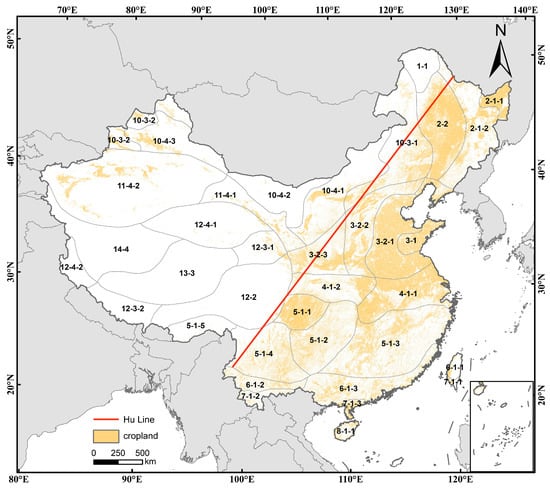
Figure 1.
Distribution of cropland in different agricultural natural zones of China in 2021 Notes: Hu Line, proposed by Hu Huanyong in 1935, divided China into two regions (southeast and northwest) of comparable area size but drastically different in population. The numbers in the figure represent different agricultural natural zones. Table 1 shows the specific names of agricultural natural zones.
2.2. Data sources and Processing
2.2.1. Landcover Data
The landcover data were obtained from the China Land Cover Dataset (CLCD) [38], which is based on all Landsat data available on the Google Earth Engine (GEE) platform. Several temporal metrics were constructed and fed to the random forest classifier to obtain annual 30 m land use/cover classification results with an overall accuracy of 79.31%. The data include nine categories, which are cropland, forest, shrub, grassland, water, snow, barren, and impervious. Their F1 Score is 82.6%, 85.5%, 35.2%, 72.2%, 87.1%, 84.0%, 82.0%, and 73.5%, respectively. Shrubs are easily misclassified into grasslands and forests, resulting in lower classification accuracy. However, in our study, shrubs, grasslands, and forests were reclassified into one category, so these data can be used in our study. CLCD was used to extract abandoned cropland and the regions of the GGP.
2.2.2. Digital Elevation Model
The digital elevation model was downloaded from the Shuttle Radar Topography Mission V3 product (SRTM Plus) provided by NASA Jet Propulsion Laboratory (https://www.jpl.nasa.gov/ (accessed on 6 January 2023)), with a spatial resolution of 1 arc second (about 30 m). DEM was used to analyze the topographic effects of the spatial distribution of abandoned cropland.
2.2.3. Agricultural Natural Zones
The vector map of the agricultural regionalization of China was acquired from the Resource and Environment Data Cloud Platform (http://www.resdc.cn (accessed on 6 January 2023)). It is a division of China into 38 agricultural natural zones based on temperature zones and humidities by Bingwei Huang [20]. Since there is no cropland in Nansha Islands, East Zhongsha, and Xisha Islands, we only discussed the remaining 36 agricultural natural zones. The zone was used to analyze the spatio-temporal characteristics of abandoned cropland.
2.2.4. Statistical Data
Per capita disposable income data of urban and rural residents were taken from the China Statistical Yearbook (http://www.stats.gov.cn/sj/ndsj (accessed on 6 January 2023)). These statistical data were used to analyze the driving factors of abandoned cropland.
All the above raster data were preprocessed including unifying the coordinate system (Albers conical equal area), the temporal resolution (yearly), and spatial resolution (30 m).
2.3. Identification Algorithm of Cropland Abandonment and Reclamation
In this study, the time sliding window method is used to extract cropland abandonment and reclamation [14]. Figure 2 shows the identification process in detail. Firstly, the abandoned cropland, new cropland, and the regions of GGP were extracted using the time sliding window method. Then, the abandoned cropland map was corrected using the regions of GGP and the final abandoned cropland map was generated. Finally, the corrected abandoned cropland map was used to extract the reclaimed abandoned cropland from the new cropland. The specific methods are as follows:
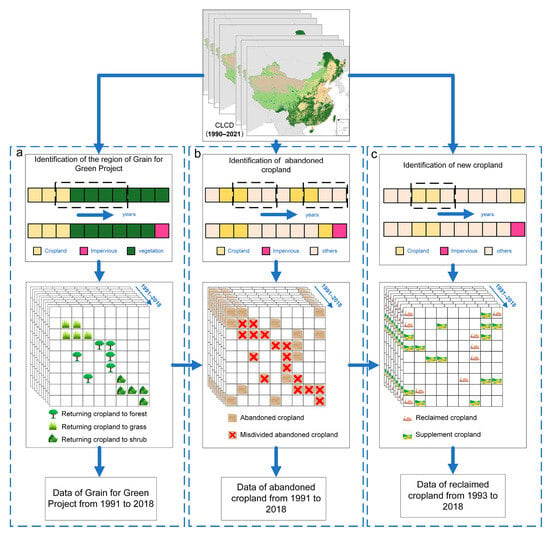
Figure 2.
Identification of cropland abandonment and reclamation. (a) Identification algorithm for Regions of GGP. (b) Identification algorithm of Abandoned Cropland. (c) Identification algorithm of Reclaimed Cropland.
2.3.1. Identification of the Regions of GGP
Figure 2a shows the process used to identify the regions of GGP. We refer to Chen et al. (2022) [33] and reclassify the land use types in the CLCD into 3 categories: cropland, vegetation, and other land, with cropland set to 1, vegetation (shrub, grassland, and forest) set to 0, and other land use types set to 2. A time sliding window with a window size of 5 years and a step size of 1 year is used to detect GGP pixel. If the pixel is converted from cropland (value = 1) to vegetation (value = 0) and lasts for 4 years, we assume that the cropland pixel was part of the GGP in the first year of conversion to vegetation. Certainly, some pixels identified as GGP pixels would become non-vegetation pixels in the subsequent years. Because China has implemented strict GGP, the vegetation in the regions of the GGP has rarely been damaged. Therefore, we excluded this type of pixel and only the pixels that subsequently stabilize into vegetation were taken as the final regions of GGP.
2.3.2. Identification of Abandoned Cropland
Figure 2b shows the process used to identify abandoned cropland. We reclassified the land use types in the CLCD into 3 categories: cropland, impervious surface, and other land use types, with cropland set to 1, impervious surface set to 2, and other land use types set to 0. A time sliding window with a window size of 3 years and a step size of 1 year is used to detect abandoned cropland. If the first year in the window is cropland (value = 1) and the second year and third year pixel is other land use type (value = 0), the second year is marked as the year of abandonment. We excluded pixels that were converted from cropland to impervious surface, because such pixels are difficult to convert to other land use types.
2.3.3. Identification of Reclaimed Cropland
Figure 2c shows the process used to identify new cropland. The new cropland includes supplementary cropland and reclaimed abandoned cropland. Similar to the method used to identify abandoned cropland, we used a time sliding window with a window size of 3 years and a step size of 1 year to detect new cropland. If the first two years of the window are other land use types (value = 0) and the third year is cropland (value = 1), we set the pixel of the third year as new cropland. If the pixel was previously identified as abandoned cropland, it is marked as a reclaimed abandoned cropland, otherwise it is marked as supplementary cropland.
2.4. Accuracy Verification
The accuracy of the results was verified by visual interpretation. Ground variation based on Google historical images is a reliable reference for accuracy evaluation, which is widely used for accurate assessment of surface detection [14]. However, Google historical images could not form a continuous time series in some regions. In order to improve the accuracy of visual interpretation, we invoked the available Landsat images of all sample sites on Google Earth Engine platform to plot the NDVI time series during the study period (Figure 3).
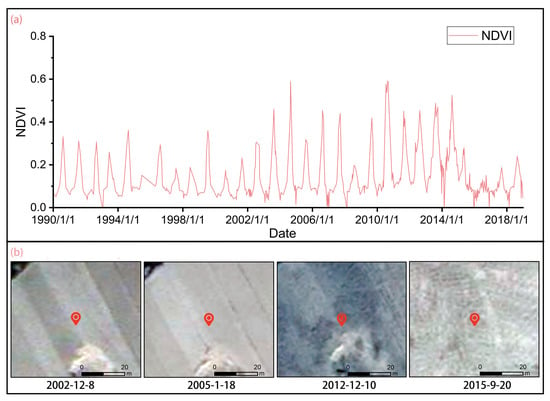
Figure 3.
(a) Landsat NDVI time-series. (b) Google history image. Notes: The red symbol is the same place at different times.
2.5. Calculation of Abandonment Frequency
There is the phenomenon of reclamation after cropland abandonment, so there will be multiple abandonment occurrences. After detecting abandoned cropland, the window will continue to slide. If abandonment is detected again, it means that the pixel has multiple abandonment phenomena. In order to record and analyze this situation, the frequency of abandonment was counted under each pixel and a map of the frequency of abandonment was generated.
2.6. Identification of Abandonment Duration
There is a relationship between the duration of cropland abandonment and the difficulty of reclamation. Therefore, the abandonment duration of cropland in China was mapped based on the method of abandonment frequency and reclamation year. Specifically, for the pixels that had been abandoned once during the study period, the duration of each pixel from the year of abandonment to the year of reclamation was calculated. For pixels that have been abandoned several times, the duration from the year of the last abandonment to the year of reclamation was calculated. For pixels where no reclamation occurred, the duration from the year of abandonment to the last year of the study period was calculated.
2.7. Abandonment Rate and Reclamation Rate Calculation
Cropland abandonment rate (CAR) refers to the proportion of the total area of abandoned cropland in the total area of cropland. The calculation formula is as follows:
where represents the total area of abandoned cropland in region ; represents the total area of cropland in region .
Reclamation rate (RR) refers to the proportion of the total area of reclaimed abandoned cropland in the total area of abandoned cropland. The calculation formula is as follows:
where represents the area of reclaimed abandoned cropland in region .
3. Results
3.1. Overview of Abandoned Cropland
3.1.1. Characteristics of Abandonment and Reclamation in Cropland
This study provided an improved time sliding window algorithm that takes GGP into account to map the overall distribution of abandoned cropland in China during 1991–2018 (Figure 4). The results showed that a total of 26.47 million hectares of cropland have been abandoned in the study period, with abandonment occurring mainly east of the Hu line. The abandoned cropland had obvious spatial differentiation of longitude, which is mainly distributed between 104° E and 126° E, with 84.04% of abandoned cropland.
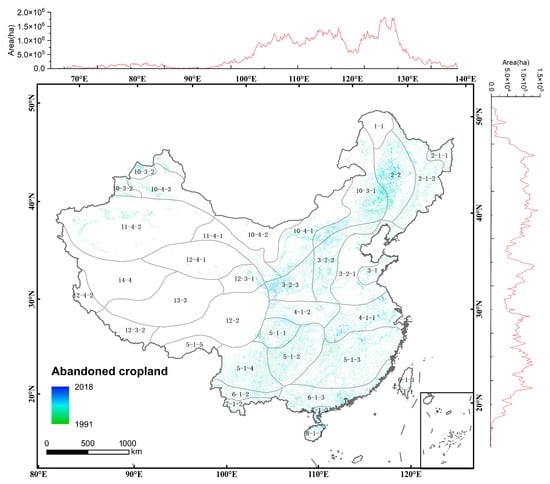
Figure 4.
Spatio-temporal distribution of abandoned cropland in China.
Figure 5 shows the annual area of abandoned cropland changes. The results showed that the area of new abandoned cropland in China showed a trend of fluctuating upward and then downward. The most abandoned cropland was added in 2004, with an abandoned area of 1.5 million hectares, and the least abandoned cropland was added in 2018, with an abandoned area of 115.8 thousand hectares. The total area of abandoned cropland in China showed a trend of increasing and then decreasing from 1991 to 2018. This may be due to the fact that 2004 was a year of rapid urbanization in China, with a large influx of rural population into the cities, resulting in cropland abandonment. Moreover, with the introduction of various cropland protection policies by the state in recent years, the newly abandoned cropland area is also decreasing. In addition, a total of 24.1 million hectares of abandoned cropland was reclaimed during 1993 to 2018, with an average annual reclaimed area of 926.5 thousand hectares. The largest area was reclaimed in 2012, with 2.3 million hectares, and the smallest area was reclaimed in 1993, with 190.9 thousand hectares. Although the total area of abandoned cropland has started to decrease, there are still more than 6 million hectares of abandoned cropland untreated in 2018, and the abandonment rate is more than 5%. The management and reclamation of abandoned cropland is still an important tool to ensure food security in China.

Figure 5.
Temporal changes in new abandonment, total abandonment, and reclamation in China.
3.1.2. Characteristics of the Frequency of Cropland Abandonment
The frequency of abandonment of abandoned cropland in China during 1991 to 2018 was counted (Figure 6). The results showed that the abandoned cropland was mainly abandoned at once, among which 23.61 million hectares (89.20%) had been abandoned once, 2.75 million hectares (10.39%) had been abandoned twice, and 0.11 million hectares (0.41%) had been abandoned three times or more. Multiple abandonment requires multiple reclamation, each time requiring large investments for treatment and restoration, wasting agricultural input costs [39]. To reduce these negative impacts, the soil and ecological environment can be protected by adopting circular and sustainable agriculture methods, such as rational fertilization, crop rotation, and afforestation.
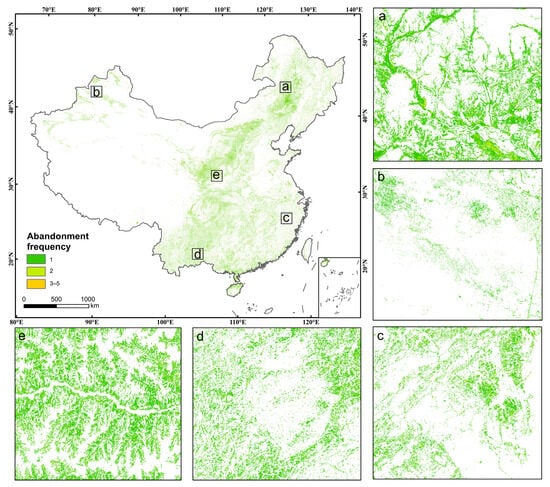
Figure 6.
Map of frequency of abandoned cropland in China. Enlarged maps made by (a–e) for the selected areas.
3.1.3. Characteristics of the Duration of Cropland Abandonment
There is a relationship between the duration of abandonment and the difficulty of reclamation. The longer the duration of abandonment, the more difficult it is to reclaim and the more effort and resources are needed to restore the productivity of the cropland. The environmental changes that may be caused by abandoned cropland also depend on the duration of abandonment [7]. Therefore, the duration of cropland abandonment in China was mapped (Figure 7). The results showed that 39.85% of cropland was abandoned for less than or equal to 6 years, 30.00% of cropland was abandoned for 7–12 years, 18.07% of cropland was abandoned for 13–18 years, 20% of cropland was abandoned for 15–20 years, and 12.08% of cropland was abandoned for more than 19 years. Reclamation of long-term abandoned cropland requires a comprehensive cropland survey and assessment, and appropriate reclamation measures, such as improving soil quality and controlling water sources, in order to restore the productivity and ecological functions of the cropland as much as possible. For short-term abandoned cropland, reclamation is relatively less difficult, and only simple measures such as soil loosening, fertilization, and planting of suitable crops are needed to restore the fertility and yield of the cropland.
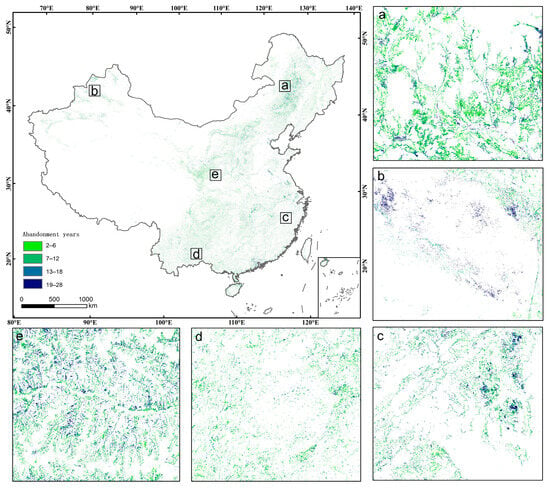
Figure 7.
Map of the duration of abandoned cropland in China. Enlarged maps made by (a–e) for the selected areas.
3.1.4. Characteristics of Abandoned Cropland in the Agricultural Natural Zones Scale
The reclamation area, reclamation rate, abandonment rate, and total abandoned area were discussed on the scale of agricultural natural zones (Figure 8). From 1991 to 2018, the highest average annual abandoned cropland area was in the Songliao Plain, with an average annual abandoned cropland area of 1.86 million hectares. There are six agricultural regions in China where the average annual area of abandoned cropland surpasses 1 million hectares, with these regions accounting for 55.52% of the total abandoned cropland in the country. Although the abandoned cropland area in the Songliao Plain, the Middle and Lower Yangtze River, and the North China Plain is large, the abandonment rate is not high because the cropland area in these regions is also large, with an average annual abandonment rate of less than 5%. The average annual abandonment rate in the North China Plain is even only 1%. The highest average annual abandonment rate is in the Southern Qiangtang Region, with an average annual abandonment rate of 49.75%. There are seven agricultural regions in China where the average annual abandonment rate surpasses 10%. Although the abandonment rate is high in other regions except for Southern Hainan Island, the abandonment area is not large. The average annual abandonment area in these areas does not exceed 20 thousand hectares.
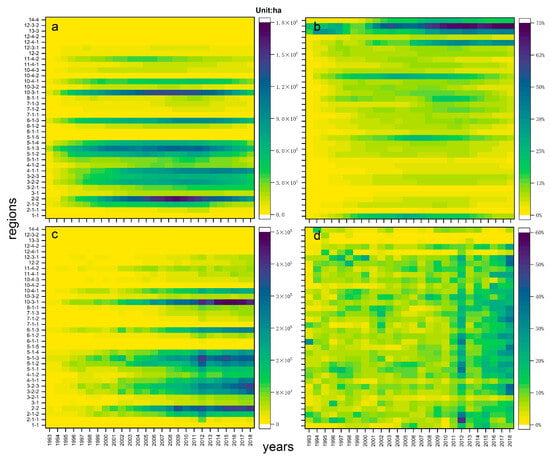
Figure 8.
(a) Abandonment area and (b) abandonment rate for each region for the period 1991–2018; (c) reclamation area and (d) reclamation rate for each region for the period 1993–2018.
From 1993 to 2018, the Sichuan Basin had the highest average annual reclamation rate of 12.72%. There are 15 agricultural regions in China where the reclamation rate surpasses 10%. The Eastern Inner Mongolia has the highest average annual reclamation area, with an average annual reclamation area of 218.9 thousand hectares. There are eight agricultural regions in China where the reclamation area surpasses 100 thousand hectares.
We believe that regions with high abandonment rates, such as Western Tibet, Southern Tibet, Western Inner Mongolia, the Northern Daxing’an Mountains, the Northern Qiangtang Region, and the Southern Himalayas, should not be priority regions for the government, because they have little cropland and poor farming conditions. The government should pay more attention to the Songliao Plain, the Middle and Lower Yangtze River, and the North China Plain, which have low abandonment rates but large abandonment areas. The Jiangnan Hills, the Hilly Areas of Fujian and Guangdong Province, the North China Mountains, and Eastern Inner Mongolia should be focused on. These regions not only have a large abandoned area, but also have a high abandonment rate.
We are concerned that in the alpine subalpine zone, the plateau cold zone, and the cold temperate zone, cropland is scarce, and the soil is mostly bleach soil, alpine desert soil, or alpine grassland soil, which is not suitable for crop growth. Therefore, the cropland abandonment of these regions is extremely serious. In the middle temperate zone, warm temperate zone, and north subtropical zone, most of the soils are dark brown loam, brown loam, and yellow brown loam, with high soil fertility and excellent water and heat conditions, which are very suitable for crop growth. Therefore, the abandonment rate in these regions is low.
3.2. Topographic Effects of Abandoned Cropland Distribution
Generally speaking, the convenience of cultivation is an important factor affecting the occurrence of cropland abandonment [29]. Cropland with steeper slope, higher elevation, and inconvenient access is more likely to be abandoned [14]. Therefore, the slope and elevation were adopted to analyze the topographic effect of abandoned cropland distribution (Figure 9). The results showed that the abandoned cropland was mainly located at low elevation and gentle slope, but the abandonment rate of cropland tends to increase with the increase in elevation and slope. From the perspective of slope, the abandoned cropland in China is mainly concentrated in the region of 0° to 15°, and the abandoned cropland in this region accounts for 82.69% of the total abandoned cropland. The region of 2° to 6° has the largest area of abandoned cropland, accounting for 38.10% of the total abandoned area. The region of 25° or more has the least area, accounting for only 4.00% of the total abandoned area. From the perspective of elevation, the abandoned cropland in China is mainly concentrated in the region of 0 m to 1500 m, and the abandoned cropland in this region accounts for 86.59% of the total abandoned cropland. The abandoned cropland in the region of 0 m to 500 m has the largest area, accounting for 54.47% of the total abandoned cropland, and the abandoned cropland above 3000 m has the least area, accounting for only 0.20% of the total abandoned cropland. It is worth noting that abandoned cropland also exists in regions below sea level, mainly in the Turpan Basin and coastal regions such as Guangdong and Jiangsu Provinces. This is mainly due to the fact that coastal regions are enclosing sea for farming, and most of the Turpan Basin is below sea level.
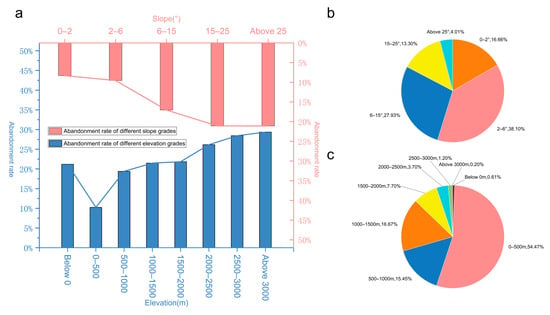
Figure 9.
(a) Abandonment rate of cropland under different elevation and slope grades. (b) Proportion of abandoned cropland under different slope grades. (c) Proportion of abandoned cropland under different elevation grades. Notes: The elevation grades are divided at an interval of 500 m, and the slope grades are based on the Technical Regulations of Land Use Status Survey issued by China Agricultural Zoning Committee in 1984.
3.3. Influence of UrbanRural Income Gap on Abandoned Cropland
The per capita disposable income ratio between urban and rural residents (PCDIRUR) is the ratio of the per capita disposable income of urban residents to the per capita disposable income of rural residents. This value is easy to calculate, so it is widely used to measure the gap between urban and rural income [40]. The greater the value, the greater the gap between urban and rural income levels, and the greater the possibility of rural labor flowing to the city. Therefore, we choose PCDIRUR to explore the impact of the urban and rural income gap on cropland abandonment. We calculated PCDIRUR and abandonment rate for each province in China from 1996 to 2018. According to the methodology of the National Bureau of Statistics, China’s provinces are divided into four parts: the eastern region, the middle region, the western region, and the north-eastern region. This classification is based on the level of economic development and spatial location [41]. The Pearson correlation coefficient between PCDIRUR and abandonment rate in each region was calculated by SPSS 23 software (Figure 10). On the national scale, the correlation coefficients of the PCDIRUR and the abandonment rate is 0.43. On the region scale, correlations range from 0.29 to 0.38. The highest correlation is in the eastern region, which may be due to the high urbanization level in the eastern region, the good urban employment environment, and the lower return rate of agriculture compared with other industries, so cropland abandonment is more likely to occur. We also selected four developed eastern coastal regions of Guangdong Province, Jiangsu Province, Shanghai, and Jiangsu Province for correlation calculation, and the correlation was as high as 0.712. This also confirms our judgment. The correlation is slightly lower in the western region than in the eastern region. This may be due to the low fertility of cropland in the western region, especially in the arid region of Northwest China, where the climate is dry and rainfall is less, the water conservancy facilities of some cropland are in disrepair, and the cropland has low resistance to natural disasters. The decline in the value of cropland will lead to cropland abandonment. The north-eastern region is industrially developed. Although the cropland is fertile and the grain yield is high, the return rate of agriculture is still low compared with industry, which is also a reason for the cropland abandonment in the north-eastern region.
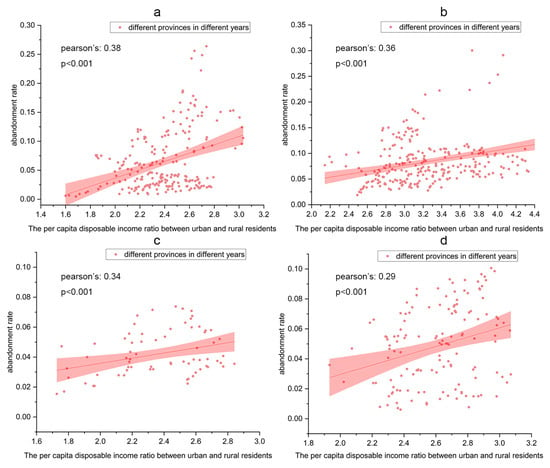
Figure 10.
The correlation between the abandonment rate and PCDIRUR in (a) the eastern region, (b) the western region, (c) the north-eastern region, and (d) the middle region. Notes: Pink backcolor is the confidence interval.
We believe that the income gap between urban and rural regions is also an important factor that causes the loss of rural labor and cropland abandonment. The government should adopt relevant policies to improve the return rate of agriculture, such as raising grain prices, expanding the construction of high-standard farmland, improving rural infrastructure construction, promoting the transfer of cropland according to law in an orderly manner, and actively promoting the implementation of the rural revitalization strategy.
4. Discussion
4.1. Policy-Driven Changes in Abandoned Cropland
The study of long time series of abandoned cropland data can detect longer abandoned cropland and better understand the formation mechanism of abandoned cropland. This study mapped abandoned cropland in China from 1991 to 2018, which can provide data support for the government. The government can then formulate scientific and rational policies to prevent such problems from becoming more serious. According to the results of our study, the total area of abandoned cropland in China increased year by year from 1991 to 2008, remained basically the same from 2008 to 2011, and began to decrease year by year from 2011 to 2018. This may be explained by the fact that 1992 to 2011 was a period of comprehensive and rapid urbanization in China, and a large number of rural laborers went to the cities for employment, making the phenomenon of uncultivated rural cropland intensify [42]. The increase in abandoned cropland in China was halted by the global economic crisis in 2008, when urban employment opportunities became scarce and rural labor was retained [43]. In 2009 and 2010, the No. 1 document for two consecutive years required continued adherence to the red line of cropland and the establishment of a protection compensation mechanism, which strengthened the responsibility for protection of cropland [44]. Since the 18th National Congress of the Communist Party of China, the government has implemented a strict cropland protection policy and established a national food security strategy of “self-oriented, based on domestic, ensuring production capacity, moderate import, and scientific and technological support” [45]. The total area of abandoned cropland has also decreased significantly in recent years. This result shows that the implementation of China’s arable land protection policy has been successful in curbing the further development of the cropland abandonment phenomenon.
4.2. Potential of Abandoned Cropland
According to the rules on GGP by the National Forestry and Grassland Administration, cropland with 15° to 25° in important water source areas and cropland with slope greater than 25° shall gradually implement GGP [46]. Abandoned cropland provides the background for GGP. In implementing GGP for land which is unsuitable for farming or gas been abandoned for too long, not only does is food production capacity not lot, but the ecological environment and optimize the allocation of resources can also be improved. Using the 2018 abandoned cropland map as the base map, we extracted abandoned cropland above 25° as well as 15° to 25° degrees in areas of important water sources. We found that there are 527 thousand hectares of potential regions for GGP in China.
Compared with new cropland, reclamation of abandoned cropland is more economically feasible. China has more than 6 million hectares of abandoned cropland, which has huge production potential. Although China is now self-sufficient in grain production, with a self-sufficiency rate of more than 98% for the three major staple foods, China’s soybean deficit is still very large [47], with a self-sufficiency rate of only 18.2%. In this paper, soybean yields were calculated for each province based on the soybean planted area and production of 34 provincial administrative units nationwide. It is then estimated that under ideal conditions soybean productivity after reclamation of abandoned cropland could reach nearly 14 million tons, which would achieve a 69% increase in soybean production in China. Although we excluded abandoned cropland above 25° and at 15° to 25° in important water source areas, low quality of cropland and poor farm facilities are not considered. Therefore, using soybean yields alone to represent soybean productivity on abandoned cropland will result in some errors compared to the actual situation. For example, abandoned cropland that has been abandoned for too long and has poor soil quality will not reach the predicted soybean productivity even after a short period of reclamation. Moreover, it is not possible to grow soybeans on all abandoned cropland after reclamation, so our estimates may be overestimated. In the next study, we will obtain more suitable abandoned cropland for soybean production based on crop model estimation or scenario analysis, and more accurately predict soybean productivity on abandoned cropland to ensure national food security.
4.3. Contributions and Shortcomings of This Study
In recent years, China has introduced various policies to reclaim abandoned cropland for food production. Obtaining the spatial distribution of abandoned cropland is the key task of reclamation. We defined abandoned cropland as cropland that has not been in agricultural production for 2 years and used a time sliding window of 3 years to detect abandoned cropland. The results show that there are 23.68 million hectares of abandoned cropland in China in 2020 (excluding those that have been reclaimed), a result that is clearly unreasonable, including a large amount of cropland that has implemented GGP. Therefore, our research was based on the time sliding window method to draw the regional map of China’s GGP to correct the extracted abandoned cropland, and finally generated a 30 m spatial resolution distribution map of abandoned cropland in China. In addition, the trend of cropland abandonment and reclamation, the frequency of abandonment, and the duration of abandonment from 1991 to 2018 were analyzed. Our method also has reference value for extracting abandoned cropland from other countries around the world. According to the definition of abandoned cropland in different countries and regions, the size of the time sliding window can be changed. If a country or region has implemented GGP, such as China, the United States, Europe, etc., then it is necessary to further extract the areas of GGP and correct the extracted abandoned cropland. However, there are still some problems in our study:
- The overall accuracy (OA) of this study using land use data (CLCD) is 79.31%, and the errors of land use data will be inevitably transferred to the abandoned cropland map;
- This study uses a time sliding window with window size of 5 years to identify the regions of GGP, so we need to collect 5 years of annual remote sensing data to identify the regions of GGP for one year. Therefore, the timeliness of the spatial distribution of abandoned cropland cannot be guaranteed.
5. Conclusions
Based on 30 m spatial resolution land use data (CLCD), this study extracted abandoned cropland from 1990 to 2018 using a time sliding window with a step size of 1 year and a window size of 3 years, and excluded the regions of GGP. We further analyzed the spatial distribution, reclamation, abandonment frequency, and duration of abandonment of abandoned cropland in China. The potential of abandoned cropland in terms of both reclamation and GGP was analyzed. The main conclusions are summarized below:
- (1)
- The average annual abandonment rate in China during 1990 to 2018 was 4.59%, with the highest total area of abandoned cropland in China reaching 1.33 million hectares in 2012. The average annual reclamation rate during the study period was 9.40%, with the highest reclamation rate occurring in 2018, when the reclamation area reached 1.50 million hectares. We also found that the reclaimed area exceeded the new abandoned area in recent years, but there are still large areas of abandoned cropland. As of 2018, there were still more than 6 million hectares of abandoned cropland;
- (2)
- There are two types of regions that need to be focused on among the 36 agricultural natural regions. One is those where the total area of abandoned cropland and the abandonment rate are high, such as Jiangnan Hills, Hilly Regions of Fujian and Guangdong Province, North China Mountains, and Eastern Inner Mongolia. The other category is the regions with a large abandoned area, although the abandonment rate is not high, such as Songliao Plain, Middle and Lower Yangtze River, and North China Plain;
- (3)
- Slope and elevation are negatively correlated with the abandonment rate, while the urban-rural disposable income ratio is positively correlated with the abandonment rate.
China currently has a potential area of 527.1 thousand hectares for GGP, and the potential soybean productivity of abandoned cropland can reach 14 million tons. Our research showed that rational utilization of abandoned cropland can ensure national food security and meet the demand for food production. In the future, it is necessary to prevent the expansion of abandoned cropland from the aspects of rural revitalization, increasing grain production and policies.
Author Contributions
Conceptualization, Methodology, Resources, Investigation, Visualization, Writing—original draft, Funding acquisition, H.W.; Supervision, Project administration, Funding acquisition, Writing—review and editing, Y.X.; Formal analysis, Writing—review and editing, Z.G.; Validation, X.Z.; Writing—review and editing, G.X.; Software, H.H. All authors have read and agreed to the published version of the manuscript.
Funding
The authors would like to gratefully acknowledge the support by Fundamental Research Funds for the Central Universities (lzujbky-2021 ct11), the Gansu Provincial Natural Science Foundation (22JR5RA425), Gansu Provincial Department of Education: excellent graduate “innovation star” program (2022CXZX-110), and Second Tibetan Plateau Scientific Expedition and Research Program (STEP) (2019QZKK0603). The authors would like to thank all the editors and reviewers who participated in the review.
Data Availability Statement
All data generated or analyzed during this study are included in this published article in the form of figures and tables. Additional information about the dataset or the dataset in a different format than what is presented in this article can be obtained from the corresponding author upon request.
Conflicts of Interest
The authors declare that they have no known competing financial interests or personal relationships that could have appeared to influence the work reported in this paper.
References
- United Nations. World Population Prospects 2022: Summary of Results. Available online: https://www.un.org/development/desa/pd/content/World-Population-Prospects-2022 (accessed on 16 April 2023 ).
- van Dijk, M.; Morley, T.; Rau, M.L.; Saghai, Y. A meta-analysis of projected global food demand and population at risk of hunger for the period 2010–2050. Nat. Food 2021, 2, 494. [Google Scholar] [CrossRef] [PubMed]
- Tilman, D.; Balzer, C.; Hill, J.; Befort, B.L. Global food demand and the sustainable intensification of agriculture. Proc. Natl. Acad. Sci. USA 2011, 108, 20260–20264. [Google Scholar] [CrossRef] [PubMed]
- Campbell, J.E.; Lobell, D.B.; Genova, R.C.; Field, C.B. The global potential of bioenergy on abandoned agriculture lands. Environ. Sci. Technol. 2008, 42, 5791–5794. [Google Scholar] [CrossRef] [PubMed]
- Tollefson, J. What the war in Ukraine means for energy, climate and food. Nature 2022, 604, 232–233. [Google Scholar] [CrossRef]
- Yang, H.F.; Zhong, X.N.; Deng, S.Q.; Xu, H. Assessment of the impact of LUCC on NPP and its influencing factors in the Yangtze River basin, China. Catena 2021, 206, 105542. [Google Scholar] [CrossRef]
- Yin, H.; Brandao, A., Jr.; Buchner, J.; Helmers, D.; Iuliano, B.G.; Kimambo, N.E.; Lewinska, K.E.; Razenkova, E.; Rizayeva, A.; Rogova, N.; et al. Monitoring cropland abandonment with Landsat time series. Remote Sens. Environ. 2020, 246, 111873. [Google Scholar] [CrossRef]
- Zhang, Y.; Li, X.; Song, W. Determinants of cropland abandonment at the parcel, household and village levels in mountain areas of China: A multi-level analysis. Land Use Policy 2014, 41, 186–192. [Google Scholar] [CrossRef]
- MacDonald, D.; Crabtree, J.R.; Wiesinger, G.; Dax, T.; Stamou, N.; Fleury, P.; Lazpita, J.G.; Gibon, A. Agricultural abandonment in mountain areas of Europe: Environmental consequences and policy response. J. Environ. Manag. 2000, 59, 47–69. [Google Scholar] [CrossRef]
- Li, S.F.; Li, X.B. Global understanding of farmland abandonment: A review and prospects. J. Geogr. Sci. 2017, 27, 1123–1150. [Google Scholar] [CrossRef]
- Queiroz, C.; Beilin, R.; Folke, C.; Lindborg, R. Farmland abandonment: Threat or opportunity for biodiversity conservation? A global review. Front. Ecol. Environ. 2014, 12, 288–296. [Google Scholar] [CrossRef]
- Ustaoglu, E.; Collier, M.J. Farmland abandonment in Europe: An overview of drivers, consequences, and assessment of the sustainability implications. Environ. Rev. 2018, 26, 396–416. [Google Scholar] [CrossRef]
- Dara, A.; Baumann, M.; Kuemmerle, T.; Pflugmacher, D.; Rabe, A.; Griffiths, P.; Hoelzel, N.; Kamp, J.; Freitag, M.; Hostert, P. Mapping the timing of cropland abandonment and recultivation in northern Kazakhstan using annual Landsat time series. Remote Sens. Environ. 2018, 213, 49–60. [Google Scholar] [CrossRef]
- Zhang, M.X.; Li, G.Y.; He, T.T.; Zhai, G.; Guo, A.D.; Chen, H.; Wu, C.F. Reveal the severe spatial and temporal patterns of abandoned cropland in China over the past 30 years. Sci. Total Environ. 2023, 857, 159591. [Google Scholar] [CrossRef] [PubMed]
- Izquierdo, A.E.; Grau, H.R. Agriculture adjustment, land-use transition and protected areas in Northwestern Argentina. J. Environ. Manag. 2009, 90, 858–865. [Google Scholar] [CrossRef]
- Song, W.; Deng, X. Land-use/land-cover change and ecosystem service provision in China. Sci. Total Environ. 2017, 576, 705–719. [Google Scholar] [CrossRef] [PubMed]
- Fourie, L. The Conservation Value of Abandoned Croplands in Mpumalanga’s Grasslands. Master’s Thesis, University of Pretoria, Pretoria, South Africa, 2014. [Google Scholar]
- Díaz, G.I.; Nahuelhual, L.; Echeverría, C.; Marín, S. Drivers of land abandonment in Southern Chile and implications for landscape planning. Landsc. Urban Plan. 2011, 99, 207–217. [Google Scholar] [CrossRef]
- Lambin, E.F.; Meyfroidt, P. Land use transitions: Socio-ecological feedback versus socio-economic change. Land Use Policy 2010, 27, 108–118. [Google Scholar] [CrossRef]
- Zhu, X.F.; Xiao, G.F.; Zhang, D.J.; Guo, L.L. Mapping abandoned farmland in China using time series MODIS NDVI. Sci. Total Environ. 2021, 755, 142651. [Google Scholar] [CrossRef]
- Han, Z.; Song, W. Abandoned cropland: Patterns and determinants within the Guangxi Karst Mountainous Area, China. Appl. Geogr. 2020, 122, 102245. [Google Scholar] [CrossRef]
- Jiang, Y.; He, X.; Yin, X.; Chen, F. The pattern of abandoned cropland and its productivity potential in China: A four-years continuous study. Sci. Total Environ. 2023, 870, 161928. [Google Scholar] [CrossRef]
- Liu, B.; Song, W. Mapping abandoned cropland using Within-Year Sentinel-2 time series. Catena 2023, 223, 106924. [Google Scholar] [CrossRef] [PubMed]
- Han, Z.; Song, W. Spatiotemporal variations in cropland abandonment in the Guizhou-Guangxi karst mountain area, China. J. Clean. Prod. 2019, 238, 117888. [Google Scholar] [CrossRef]
- Low, F.; Prishchepov, A.V.; Waldner, F.; Dubovyk, O.; Akramkhanov, A.; Biradar, C.; Lamers, J.P.A. Mapping Cropland Abandonment in the Aral Sea Basin with MODIS Time Series. Remote Sens. 2018, 10, 159. [Google Scholar] [CrossRef]
- Chinese People’s Congress. Law of the People’s Republic of China on Land Contract in Rural Areas. Available online: http://www.npc.gov.cn/npc/c30834/201901/cd063e4c0f19465e9d41946001fe839c.shtml (accessed on 18 April 2023).
- Kuntz, K.A.; Beaudry, F.; Porter, K.L. Farmers’ Perceptions of Agricultural Land Abandonment in Rural Western New York State. Land 2018, 7, 128. [Google Scholar] [CrossRef]
- Li, S.F.; Li, X.B.; Sun, L.X.; Cao, G.Y.; Fischer, G.; Tramberend, S. An estimation of the extent of cropland abandonment in mountainous regions of China. Land Degrad. Dev. 2018, 29, 1327–1342. [Google Scholar] [CrossRef]
- Hinojosa, L.; Napoleone, C.; Moulery, M.; Lambin, E.F. The “mountain effect” in the abandonment of grasslands: Insights from the French Southern Alps. Agric. Ecosyst. Environ. 2016, 221, 115–124. [Google Scholar] [CrossRef]
- Yin, H.; Prishchepov, A.V.; Kuemmerle, T.; Bleyhl, B.; Buchner, J.; Radeloff, V.C. Mapping agricultural land abandonment from spatial and temporal segmentation of Landsat time series. Remote Sens. Environ. 2018, 210, 12–24. [Google Scholar] [CrossRef]
- Estel, S.; Kuemmerle, T.; Alcantara, C.; Levers, C.; Prishchepov, A.; Hostert, P. Mapping farmland abandonment and recultivation across Europe using MODIS NDVI time series. Remote Sens. Environ. 2015, 163, 312–325. [Google Scholar] [CrossRef]
- Alcantara, C.; Kuemmerle, T.; Baumann, M.; Bragina, E.V.; Griffiths, P.; Hostert, P.; Knorn, J.; Mueller, D.; Prishchepov, A.V.; Schierhorn, F.; et al. Mapping the extent of abandoned farmland in Central and Eastern Europe using MODIS time series satellite data. Environ. Res. Lett. 2013, 8, 035035. [Google Scholar] [CrossRef]
- Chen, X.; Yu, L.; Du, Z.R.; Xu, Y.D.; Zhao, J.Y.; Zhao, H.L.; Zhang, G.L.; Peng, D.L.; Gong, P. Distribution of ecological restoration projects associated with land use and land cover change in China and their ecological impacts. Sci. Total Environ. 2022, 825, 153938. [Google Scholar] [CrossRef]
- Zhao, X.J.; Deng, G.Q.; Xi, Y.L. Spatial-Temporal Characteristics and Driving Factors of Disaster-Induced Grain Yield Loss in China. Front. Environ. Sci. 2022, 10, 808565. [Google Scholar] [CrossRef]
- Bai, X.; Shi, P.; Liu, Y. Society: Realizing China’s urban dream. Nature 2014, 509, 158–160. [Google Scholar] [CrossRef] [PubMed]
- Kuang, W.H.; Liu, J.Y.; Tian, H.Q.; Shi, H.; Dong, J.W.; Song, C.Q.; Li, X.Y.; Du, G.M.; Hou, Y.L.; Lu, D.S.; et al. Cropland redistribution to marginal lands undermines environmental sustainability. Natl. Sci. Rev. 2022, 9, nwab091. [Google Scholar] [CrossRef] [PubMed]
- Liu, J.Y.; Liu, M.L.; Tian, H.Q.; Zhuang, D.F.; Zhang, Z.X.; Zhang, W.; Tang, X.M.; Deng, X.Z. Spatial and temporal patterns of China’s cropland during 1990-2000: An analysis based on Landsat TM data. Remote Sens. Environ. 2005, 98, 442–456. [Google Scholar] [CrossRef]
- Yang, J.; Huang, X. The 30 m annual land cover dataset and its dynamics in China from 1990 to 2019. Earth Syst. Sci. Data 2021, 13, 3907–3925. [Google Scholar] [CrossRef]
- Su, Y.Y.; Wu, S.K.; Kang, S.G.; Xu, H.; Liu, G.S.; Qiao, Z.; Liu, L. Monitoring Cropland Abandonment in Southern China from 1992 to 2020 Based on the Combination of Phenological and Time-Series Algorithm Using Landsat Imagery and Google Earth Engine. Remote Sens. 2023, 15, 669. [Google Scholar] [CrossRef]
- Zhong, S.J.; Wang, M.S.; Zhu, Y.; Chen, Z.G.; Huang, X.J. Urban expansion and the urban-rural income gap: Empirical evidence from China. Cities 2022, 129, 103831. [Google Scholar] [CrossRef]
- Su, C.W.; Liu, T.Y.; Chang, H.L.; Jiang, X.Z. Is urbanization narrowing the urban-rural income gap? A cross-regional study of China. Habitat Int. 2015, 48, 79–86. [Google Scholar] [CrossRef]
- Deng, X.Z.; Huang, J.K.; Rozelle, S.; Zhang, J.P.; Li, Z.H. Impact of urbanization on cultivated land changes in China. Land Use Policy 2015, 45, 1–7. [Google Scholar] [CrossRef]
- Jebabli, I.; Kouaissah, N.; Arouri, M. Volatility Spillovers between Stock and Energy Markets during Crises: A Comparative Assessment between the 2008 Global Financial Crisis and the COVID-19 Pandemic Crisis. Financ. Res. Lett. 2022, 46, 102363. [Google Scholar] [CrossRef]
- State Council of the PRC. Several Opinions on Strengthening Overall Urban and Rural Development and Further Consolidating the Foundation of Agricultural and Rural Development. Available online: https://www.gov.cn/gongbao/content/2010/content_1528900.html/ (accessed on 18 April 2023).
- Zheng, W.W.; Li, S.M.; Ke, X.L.; Li, X.Y.; Zhang, B.B. The impacts of cropland balance policy on habitat quality in China: A multiscale administrative perspective. J. Environ. Manag. 2022, 323, 116182. [Google Scholar] [CrossRef] [PubMed]
- National Forestry and Grassland Administration. Twenty Years of Returning Farmland to Forest and Grassland in China (1999–2019). Available online: http://www.forestry.gov.cn/html/main/main_195/20200630085813736477881/file/20200630090428999877621.pdf (accessed on 18 April 2023).
- Di, Y.Y.; You, N.S.; Dong, J.W.; Liao, X.Y.; Song, K.S.; Fu, P. Recent soybean subsidy policy did not revitalize but stabilize the soybean planting areas in Northeast China. Eur. J. Agron. 2023, 147, 126841. [Google Scholar] [CrossRef]
Disclaimer/Publisher’s Note: The statements, opinions and data contained in all publications are solely those of the individual author(s) and contributor(s) and not of MDPI and/or the editor(s). MDPI and/or the editor(s) disclaim responsibility for any injury to people or property resulting from any ideas, methods, instructions or products referred to in the content. |
© 2023 by the authors. Licensee MDPI, Basel, Switzerland. This article is an open access article distributed under the terms and conditions of the Creative Commons Attribution (CC BY) license (https://creativecommons.org/licenses/by/4.0/).
